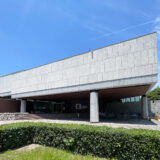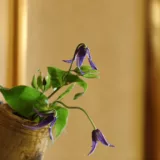The first entry in the new Kogei Art KYOTO blog’s “Kyoto Recommended Spots” category will be an introduction to the Kawai Kanjiro’s House.
The Kawai Kanjiro’s House is a museum designed by the modern Japanese potter Kawai Kanjiro, who lived there until his death. The studio, climbing kiln, and residence have been preserved as they were at the time and are open to the public.
The House is located in Higashiyama Gojo, near Kiyomizudera Temple, the birthplace of Kiyomizu-yaki pottery and long the center of the pottery industry.
Kawai’s artistic philosophy and approach

Kawai believed in the concept of “beauty of use.” This is the idea that objects used in everyday life should not only be practical but also beautiful. This philosophy challenges the distinction between art and craft, and he believed that everyday items such as bowls, vases, and plates could have value as works of art. Kawai’s pottery is characterized by bold, natural glazes and flowing, organic shapes that convey a sense of warmth and sincerity.
He did not consider himself a craftsman but an artist who used his hands and clay to create works of art. His works show a humility that accepts the natural beauty and imperfections of the materials rather than pursuing perfection.

The Mingei Movement and Kawai Kanjiro
Kawai, along with Yanagi Muneyoshi, Tomimoto Kenkichi, Hamada Shoji, and others, was deeply involved in the Mingei Movement. He sought to promote the beauty of everyday items made by anonymous artisans and create and popularize new everyday items.
In particular, Kawai’s role and achievements in the Mingei movement were that he embodied the philosophy of the Mingei movement, as provided by Yanagi Muneyoshi, through his works.
His studio in Kyoto became a base for artisans and artists trying to rediscover the beauty of traditional Japanese crafts.
Kawai, along with other craftspeople such as Hamada Shoji and Bernard Leach, established a network of artists who shared Mingei’s philosophy.
Kawai’s ceramic works were highly acclaimed internationally and were exhibited in Europe and America.
This helped spread Mingei’s philosophy outside Japan. His influence crossed borders and influenced artists and designers who appreciated the simplicity and honesty of handmade objects.
The Legacy of Kawai Kanjiro
Kawai’s studio and home, which became the base of this network of the Mingei movement, is now the Kawai Kanjiro’s House.
The inside of the House is filled with furniture and furnishings that were either designed by him or collected by him, as well as pottery and wood carvings, chairs, tables, chests of drawers, lampshades, and other items, all arranged in a haphazard way to create a unique world view constructed according to the aesthetic sense of a single artist.
These displayed items also change with the seasons, and you can almost feel the humanity of Kanjiro, who lived with his works.
In addition, the climbing kiln, which is now prohibited by Kyoto City regulations, has been preserved in the same state as it was used in those days, and it is also a very historically valuable heritage.

KAWAI KANJIRO’S HOUSE
| Address | 569 Kanetsuki-cho, Shibuya-dori Higashioji Nishi-iru Higashiyama-ku, Kyoto, 605-0875 |
| Opening hours | 10:00 – 17:00 (Reception closes at 16:30) |
| Closed | Mondays (or the following day if Monday is a public holiday), around 11 August to 20 August, around 24 December to 7 January |
| Admission | General admission: 900 yen High school and university students: 500 yen Elementary and junior high school students: 300 yen |
| Access | 2 minutes on foot from the “Umamachi” stop on the city bus 10 minutes on foot from the “Kiyomizu Gojo” station on the Keihan Main Line |
















